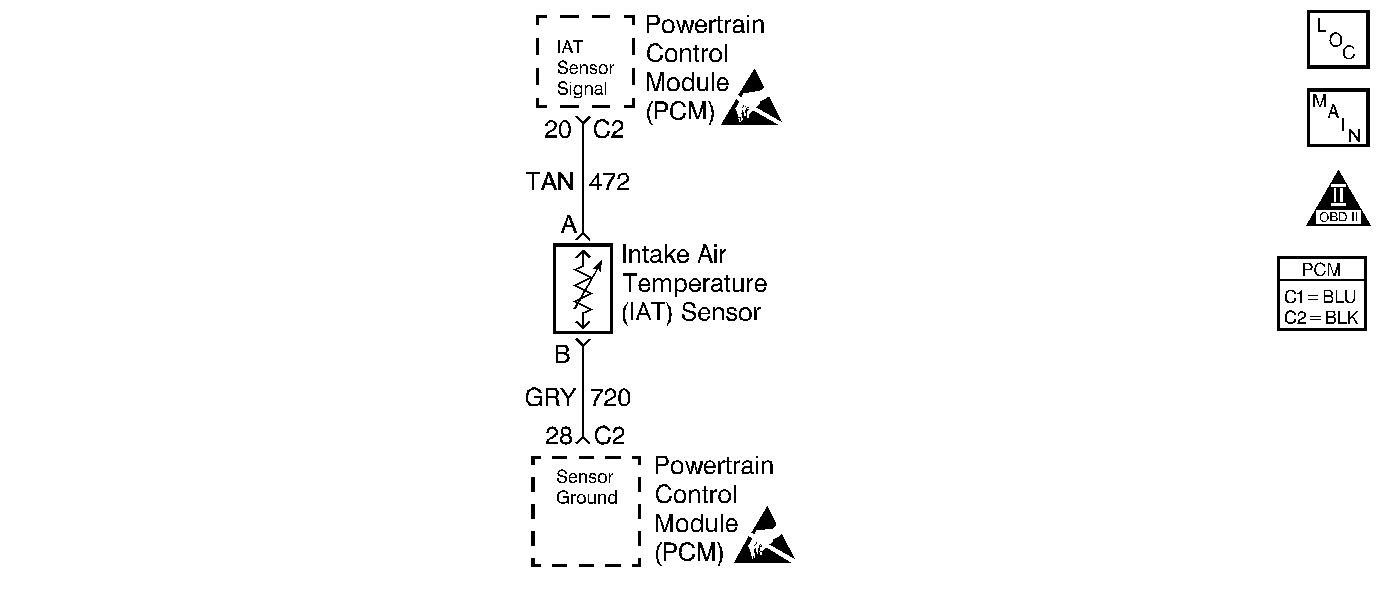
Circuit Description
The Intake Air Temperature (IAT) sensor is a thermistor which controls the signal voltage to the PCM. The PCM supplies a 5V reference and a ground to the sensor. When the air is cold, the resistance will be high. Whenever the intake air is warm, the resistance will be low.
Conditions for Running the DTC
| • | No active ECT DTC's |
| • | No active VSS DTC's |
| • | The engine run time is more than 320 seconds. |
| • | The vehicle speed is more than 15 mph (24 km/h). |
Conditions for Setting the DTC
The IAT sensor signal voltage indicates that the intake air temperature is more than 128°C (262°F) for 3.125 seconds.
Action Taken When the DTC Sets
| • | The control module illuminates the malfunction indicator lamp (MIL) if a failure is detected during 2 consecutive key cycles. |
| • | The control module sets the DTC and records the operating conditions at the time the diagnostic failed. The failure information is stored in the scan tool Freeze Frame/Failure Records. |
Conditions for Clearing the MIL or DTC
| • | The control module turns OFF the MIL after 3 consecutive drive trips when the test has run and passed. |
| • | A history DTC will clear if no fault conditions have been detected for 40 warm-up cycles. A warm-up cycle occurs when the coolant temperature has risen 22°C (40°F) from the startup coolant temperature and the engine coolant reaches a temperature that is more than 70°C (158°F) during the same ignition cycle. |
| • | Use a scan tool in order to clear the DTCs. |
Diagnostic Aids
| • | When the vehicle is at ambient temperature, compare the IAT sensor to the ECT sensor. The IAT sensor and the ECT sensor should be relatively close to each other. |
| • | Use the Temperature vs Resistance Values Table below to evaluate the possibility of a skewed sensor. Refer to Temperature Versus Resistance . |
An intermittent may be caused by any of the following conditions:
| • | A poor connection |
| • | Rubbed through wire insulation |
| • | A broken wire inside the insulation |
Thoroughly check any circuitry that is suspected of causing the intermittent complaint. Refer to Intermittents and Poor Connections Diagnosis in Wiring Systems.
If a repair is necessary, refer to Wiring Repairs or Connector Repairs in Wiring Systems.
Test Description
The numbers below refer to the step numbers on the Diagnostic Table.
-
The Powertrain OBD System Check prompts you to complete some of the basic checks and to store the freeze frame and failure records data on the scan tool if applicable. This creates an electronic copy of the data captured when the malfunction occurred. The scan tool stores this data for later reference.
-
This step simulates a DTC P0113 condition. If the scan tool displays the specified value, the IAT signal circuit and the PCM are OK.
-
Program the replacement PCM and perform the Crankshaft Position System Variation Learn Procedure. Refer to the latest Techline information for PCM programming.
Step | Action | Value(s) | Yes | No |
|---|---|---|---|---|
Did you perform the Powertrain On-Board Diagnostic (OBD) System Check? | -- | |||
2 |
Is the IAT sensor value more than the specified value? | 128°C (262°F) | ||
3 |
Is the IAT sensor value more than the specified value? | 128°C (262°F) | Go to Diagnostic Aids | |
Is the IAT sensor value below the specified value? | -30°C (-22°F) | |||
5 |
Does the test lamp illuminate? | -- | ||
6 |
Does the test lamp illuminate? | -- | ||
7 |
Was a repair necessary? | -- | ||
8 |
Was a repair necessary? | -- | ||
9 | Repair the short to ground in the IAT sensor signal circuit. Refer to Wiring Repairs in Wiring Systems. Is the action complete? | -- | -- | |
10 | Replace the IAT sensor. Refer to the Intake Air Temperature Sensor Replacement . Is the action complete? | -- | -- | |
|
Important:: The replacement PCM must be programmed. Refer to Powertrain Control Module Replacement/Programming . Replace the PCM. Is the action complete? | -- | -- | ||
12 |
Does the scan tool indicate that this diagnostic ran and passed? | -- | ||
13 | Check to see if any additional DTCs are set. Does the scan tool display any DTCs that you have not diagnosed? | -- | Go to the applicable DTC table | System OK |
